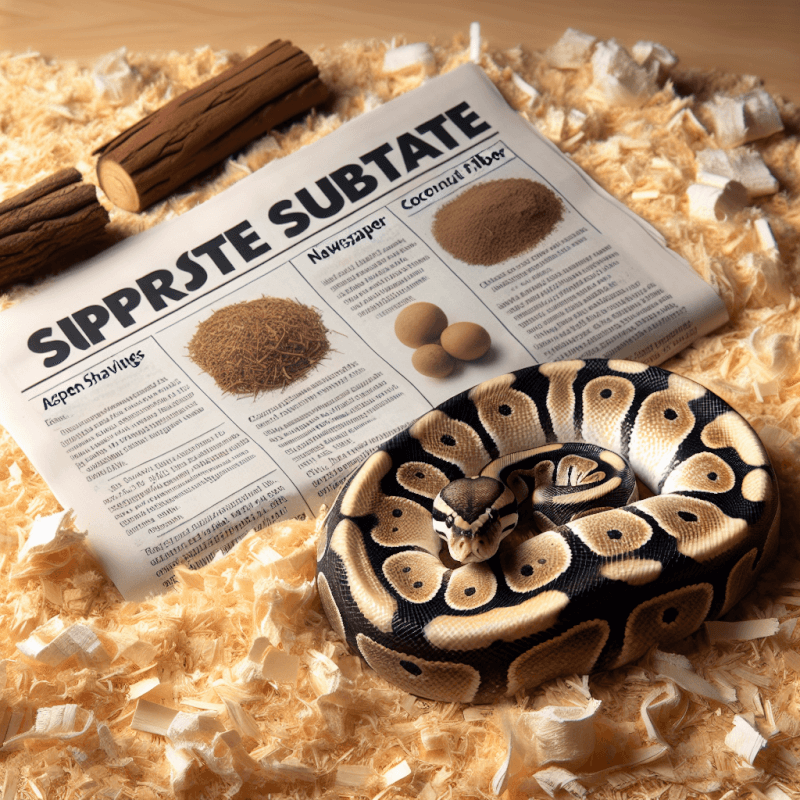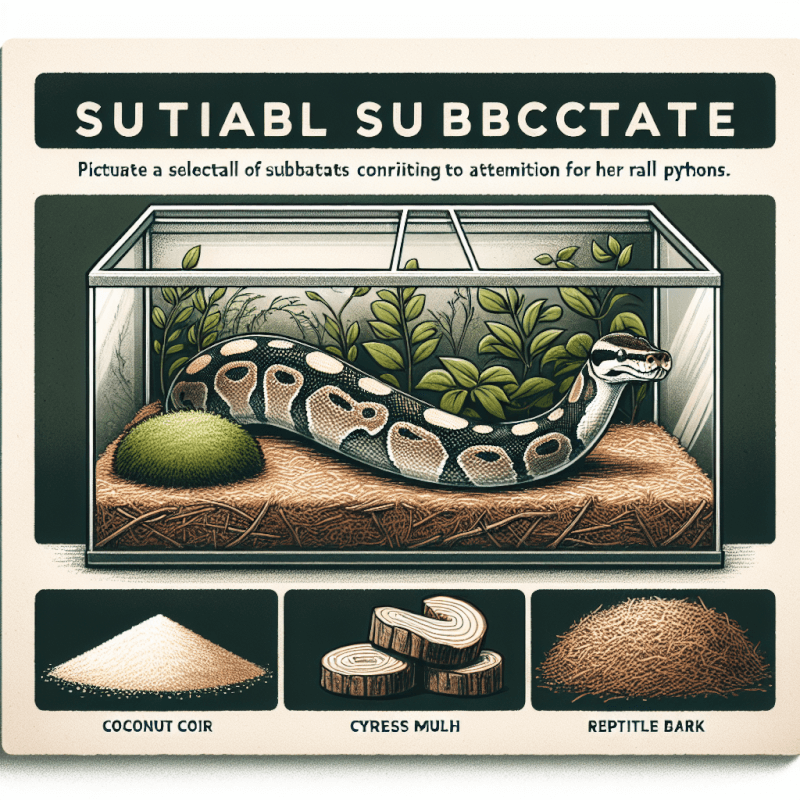Are you a proud owner of a ball python and wondering what the best substrate for your scaly friend is? Look no further, because we’ve got you covered! In this article, we will explore the various options available and help you choose the perfect substrate that will provide comfort and meet the specific needs of your ball python. From aspen shavings to coconut husk, we will delve into the pros and cons of each substrate, ensuring you make an informed decision that will keep your snake happy and healthy. So, let’s get started and find out what substrate will be the perfect match for your ball python!

Factors to Consider
When it comes to choosing the best substrate for your ball python’s enclosure, there are several factors to consider. Each factor plays an important role in creating a suitable and comfortable habitat for your pet snake. From replicating their natural environment to maintaining proper humidity levels and ensuring substrate safety, these factors will help you make an informed decision. Additionally, factors such as ease of cleaning, odor suppression, cost, appearance, availability, and personal preference should also be taken into account. Let’s explore each of these factors in detail to help you make the best substrate choice for your ball python.
Natural Habitat
Understanding your ball python’s natural habitat is crucial in setting up their enclosure. Ball pythons are native to the tropical regions of Africa, where they inhabit grasslands and open forests. In these natural habitats, they often dwell in burrows or hide among leaf litter and vegetation. Replicating their natural environment in captivity is important for their overall well-being and mental stimulation.
By providing a substrate that mimics their natural habitat, you can create a sense of security and comfort for your ball python. They will feel more at ease and exhibit natural behaviors, such as burrowing and hiding. Furthermore, a naturalistic setup promotes their overall health and reduces stress.
Humidity Requirements
Ball pythons have specific humidity requirements that must be met to ensure their health and well-being. In their natural environment, these snakes experience varying humidity levels, both during the wet and dry seasons. As captive snakes, it’s important to replicate these conditions to maintain proper humidity levels in their enclosure.
The choice of substrate plays a significant role in maintaining the ideal humidity levels for your ball python. Some substrates have better moisture retention properties, while others may dry out quickly. It’s essential to select a substrate that can help you achieve the appropriate humidity range of 50-60% for most ball pythons. This will help prevent dehydration, respiratory issues, and shedding problems.
Substrate Safety
The safety of your ball python should be a top priority when selecting a substrate. Some substrates can pose risks to your snake’s health if ingested or if they come into direct contact with potentially harmful substances. It’s crucial to choose a substrate that is safe and non-toxic for your pet.
Avoid substrates that contain chemicals, pesticides, or any harmful additives. Also, steer clear of substrates that can cause impaction if ingested, as this can lead to serious health complications. Opt for substrates that are specifically designed for reptile use and have been proven to be safe for ball pythons.

Ease of Cleaning
Maintaining a clean and hygienic enclosure is essential for your ball python’s health and well-being. Regular cleaning helps prevent the buildup of bacteria, fungi, and parasites that can cause diseases. Choosing a substrate that simplifies the cleaning process can save you time and effort.
Certain substrates are easier to clean than others. Substrates that retain waste or moisture can become breeding grounds for bacteria and result in foul odors. It’s important to select a substrate that allows for easy waste removal and doesn’t require frequent complete changes. This will make cleaning more efficient and help keep your ball python’s enclosure fresh and sanitary.
Suppressing Odors
Odor control is another important factor to consider when selecting a substrate for your ball python’s enclosure. While snakes are known for their relatively low odor levels compared to other pets, it’s still essential to minimize any unpleasant smells that may arise.
Certain substrates have properties that assist in absorbing odors and preventing their dissemination. These substrates can help keep the enclosure smelling clean and fresh for longer periods. By choosing a substrate that effectively suppresses odors, you can provide a more pleasant and comfortable environment for both you and your ball python.

Cost
Consideration of the cost of different substrates is necessary to fit your budget and long-term snake care expenses. While the initial cost of the substrate may seem insignificant, it’s important to account for the long-term costs associated with substrate changes and replacements.
Some substrates may need to be replaced frequently, while others can last longer. Analyzing the lifespan and cost-effectiveness of substrates can help you make a financially sound decision. However, it’s crucial to prioritize your ball python’s health and well-being over cost, as a suitable substrate is essential for their overall care.
Appearance
Enhancing the aesthetics of your ball python’s enclosure can be achieved with the right substrate choice. While it may not directly impact your snake’s health, a visually appealing substrate can contribute to creating a more naturalistic and visually pleasing environment.
Choosing a substrate that complements the natural beauty of your ball python’s habitat can improve your overall enjoyment of the enclosure. Whether it’s replicating the look of a forest floor or providing a clean and minimalistic appearance, the substrate can significantly enhance the visual appeal of the enclosure.

Availability
Consider the availability of different substrates when making your selection. You’ll want to choose a substrate that is readily available in your area or can be easily ordered online. Ensuring the accessibility and convenience of the chosen substrate will simplify the process of maintaining your ball python’s enclosure.
Check local pet stores for substrate availability, as they often carry a variety of options. Additionally, online retailers specializing in reptile supplies can provide greater access to a wider range of substrates. Be sure to explore your options and choose a substrate that meets your ball python’s needs and is easily accessible to you.
Substrate Options to Consider
Now that we’ve covered the various factors to consider when choosing a substrate for your ball python, let’s explore some specific substrate options that are commonly used and suitable for these snakes.
Aspen Bedding: Aspen bedding is a popular choice among ball python owners due to its excellent moisture absorption and odor control properties. It provides a natural-looking substrate that allows for burrowing and is safe for your snake.
Cypress Mulch: Cypress mulch is another substrate option that retains moisture well and helps maintain proper humidity levels. It also has good odor control properties and provides a naturalistic appearance.
Coconut Husk: Coconut husk, also known as “coir,” is a substrate made from the fibrous husk of coconuts. It retains moisture effectively and provides a natural-looking substrate that caters to the burrowing instincts of ball pythons.
Orchid Bark: Orchid bark is a popular choice for creating a natural and visually appealing enclosure. It offers good moisture retention and allows for burrowing. However, it may require more frequent cleaning due to its rough texture.
Paper-Based Substrates: Paper-based substrates, such as shredded paper or paper towels, are a low-cost and easy-to-clean option. They don’t retain moisture well, so additional misting or other humidity methods may be necessary.
Newspaper: Newspaper is another inexpensive option that is easy to clean. However, it lacks visual appeal and may not provide adequate stimulation for your ball python.
Reptile Carpet: Reptile carpet is a reusable and washable substrate that provides a flat and stable surface. While it is easy to clean, it may not provide the naturalistic benefits that other substrates offer.
Bioactive Substrates: Bioactive substrates, such as a mix of soil, leaf litter, and beneficial microorganisms, create a self-sustaining ecosystem within the enclosure. They provide naturalistic benefits and promote the breakdown of waste, reducing the need for frequent cleaning.
Combination of Substrates: You can also consider a combination of different substrates to provide a variety of textures and enrichment for your ball python. For example, using aspen bedding as the base layer and adding orchid bark or coconut husk for visual appeal and improved moisture retention.
DIY Substrate Options: Some ball python owners prefer to create their own substrates using various materials, such as a mix of organic topsoil, sand, and coconut coir. DIY substrates allow for customization and control over the substrate’s composition.
By considering these substrate options, you can choose the one that best suits your ball python’s needs and preferences.
In conclusion, selecting the best substrate for your ball python requires careful consideration of various factors. Understanding their natural habitat, meeting humidity requirements, ensuring substrate safety, ease of cleaning, odor suppression, cost, appearance, availability, and personal preference all play a crucial role in creating a suitable and comfortable enclosure for your pet snake. By evaluating each factor and exploring the different substrate options available, you can make an informed decision that promotes the well-being and happiness of your ball python. Remember to prioritize the health and safety of your snake above all else and regularly monitor their behavior and overall condition to ensure they are thriving in their carefully selected substrate.



